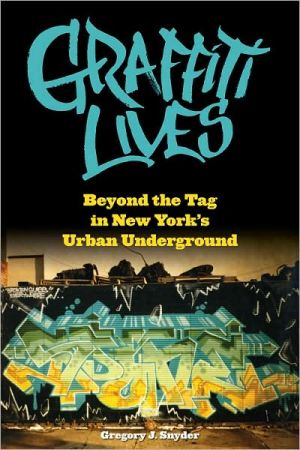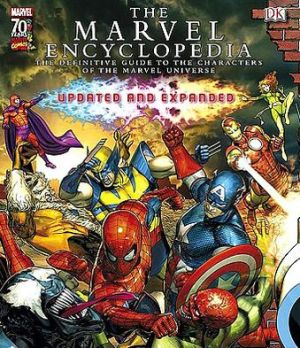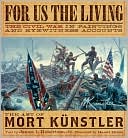Graffiti Lives: Beyond the Tag in New York's Urban Underground
"On buildings, bridges, billboards, mailboxes, and street signs, and especially in the subway and train tunnels, graffiti covers much of New York City. Love it or hate it, graffiti, from the humble tag to the intricate "piece" (short for masterpiece ), is an undeniable part of the cityscape. In Graffiti Lives, Gregory J. Snyder offers a fascinating and rare look into contemporary graffiti culture. Based on over ten years of extensive research, Snyder brings to life this largely unknown world...
Search in google:
On the sides of buildings, on bridges, billboards, mailboxes, and street signs, and especially in the subway and train tunnels, graffiti covers much of New York City. Love it or hate it, graffiti, from the humble tag to the intricate piece (short for masterpiece), is an undeniable part of the cityscape.In Graffiti Lives, Gregory J. Snyder offers a fascinating and rare look into this world of contemporary graffiti culture. A world in which kids, often, shoplift for spray paint, scale impossibly high places to find a great spot to 'get up,' run from the police, journey into underground train tunnels, fight over turf, and spend countless hours perfecting their style. Over the ten years Snyder studied this culture he even created a few works himself (under the moniker 'GWIZ'), found himself serving as a lookout for other artists engaged in this illegal activity, spent time in the train tunnels in search of new work, created a blackbook for writers to tag, and took countless photographs to document this world — over sixty included in the book.A combination of amazing 'flicks' and exhilarating prose, Graffiti Lives is ultimately an exploration into how graffiti writers define themselves. Snyder details that writers are not bound together by appearance or language or birthplace or class but by what they do. And what they do is reach for fame, painting their names as prominently as they can. What's more, he discovers that, though many public officials think graffiti writing will only lead to other criminal activity, many graffiti writers have turned their youthful exploits into adult careers — from professional aerosol muralists and fine artists todesigners of all kinds, employed in such fields as tattooing, studio art, magazine production, fashion, and guerilla marketing. In fact, some of the artists featured have gone on to international acclaim and to their own gallery shows. Snyder's illuminating work shows that getting up tags, throw-ups, and pieces on New York City's walls and subway tunnels can lead to getting out into the city's competitive professional world. Graffiti Lives details the exciting, risky, and surprisingly rewarding pursuits of contemporary graffiti writers.Publishers WeeklyStarred Review. In his first book, fan and socio-anthropologist Snyder doesn't just celebrate urban street art and its rising stars, but takes a thorough look at its history and future, the language of public art and the idea of the graffiti artist as criminal-including an intriguing challenge to the "broken windows theory" cited by law enforcement and NYC government officials as central to their efforts. Along the way he decodes a backdoor in the East Village covered with a dozen different tags-"in the same way that the sedimentary layers of ancient ruins inspire archaeologists to tell tales of past civilizations"-profiles rising and established stars, and takes a raw, detailed tour of the scene with guidance from writers like ESPO, MEK, and AMAZE (their trip through the "Freedom Tunnel" from 72nd Street to 125th Street under Riverside Drive is especially exciting). Snyder's "the kids are alright" assessment, buttressed by many examples of thrill-seeking taggers finding successful careers in art, design, publishing, and (commissioned) mural-painting, is well-articulated, convincing, and quite possibly reassuring for the urbanites living among (or perhaps raising) today's writers and bombers.Copyright © Reed Business Information, a division of Reed Elsevier Inc. All rights reserved.
Introduction 11 Getting InStarting the Blackbook 13A Brief History of Graffiti Writing 23Crime Space vs. Cool Space: Breaking Down Broken Windows 472 Getting UpVERT: First Contact 59Writer's Block: Blackbook in the Streets 65Welcome to ESPO Land 73ESPO: Illustrating Struggle 81Into the Tunnel: Under Manhattan 85A Pilgrimage to MEK: A Bronx Graffiti Tour 89Legal Graffiti: Contemporary Permission Spots 97Style Points: ESPO's Brooklyn Mural 105Illustrating Criminal: Split PSOUP 115AME: Bombing Styles, Inventing Self 119AMAZE: Out-of-Towner Gets Up in the Tunnel 129The Grate Graffiti Solution: ESPO's Public Surface Announcement 1373 Getting OutOver the Wall: Graffiti Media and Creating a Career 147Writing Style: It's Not What You Wear 159Career Opportunities: Rewriting Subculture Resistance 167Timmy Tattoo: Timmy's Long Island Tattoo Shop 173Gabe Banner: Market Wise 177ESPO/Steve Powers: Dreamland Artist Club 181CODA: Graffiti for Life 189Appendix The New Ethnography 191Glossary 199Notes 203Bibliography 219Index 227
\ Publishers WeeklyStarred Review. \ In his first book, fan and socio-anthropologist Snyder doesn't just celebrate urban street art and its rising stars, but takes a thorough look at its history and future, the language of public art and the idea of the graffiti artist as criminal-including an intriguing challenge to the "broken windows theory" cited by law enforcement and NYC government officials as central to their efforts. Along the way he decodes a backdoor in the East Village covered with a dozen different tags-"in the same way that the sedimentary layers of ancient ruins inspire archaeologists to tell tales of past civilizations"-profiles rising and established stars, and takes a raw, detailed tour of the scene with guidance from writers like ESPO, MEK, and AMAZE (their trip through the "Freedom Tunnel" from 72nd Street to 125th Street under Riverside Drive is especially exciting). Snyder's "the kids are alright" assessment, buttressed by many examples of thrill-seeking taggers finding successful careers in art, design, publishing, and (commissioned) mural-painting, is well-articulated, convincing, and quite possibly reassuring for the urbanites living among (or perhaps raising) today's writers and bombers.\ Copyright © Reed Business Information, a division of Reed Elsevier Inc. All rights reserved.\ \ \ \ \ \ Kirkus ReviewsNot all graffiti artists are hoodlums, declares Snyder (Sociology and Anthropology/Baruch Coll.). Possibly the best thing about this ethnographic thesis on New York graffiti artists is that the author doesn't pretend to be one of them. He exhaustively lays out his own background-Irish-Catholic kid in Green Bay, Wis.; ardent lover of punk rock and hip-hop in college; misfit graduate student at the New School in New York City-before getting much into those of the men he is writing about. (This is not, by and large, a woman's world.) Snyder follows ethnographic discipline to a fault, explaining time and again what his methods of field research were and how he came into contact with the graffiti "writers" who spread their art over the walls, tunnels and store grates of New York. More suitable for a paper being presented to a degree review board than for a general-interest book, this approach doesn't leave much room for his actual on-the-ground research, most of which was conducted in the late '90s and is now out of date. There are some worthwhile passages amid the portentously deployed academese, however, particularly those on the writers' actual working methods. Snyder may hammer home a few points with numbing repetitiveness, but the points are worth making. First, the connection between rap culture and graffiti is weaker than most people believe; many of the artists here identify more closely with punk than rap. Second, graffiti as an art form doesn't necessarily have a direct link to criminality. The author points out that it's frequently thicker in tourist areas like Soho than in poorer, less-trafficked locales, showing that for most writers having their work seen is more important thananything else. Snyder, who clearly became too close to his subjects to retain much objectivity, too breezily brushes aside citizens' concerns about graffiti. Nonetheless, his book will prompt readers to look again at graffiti scrawls they may previously have ignored. A few kernels of insight buried under layers of grad-student balderdash.\ \








